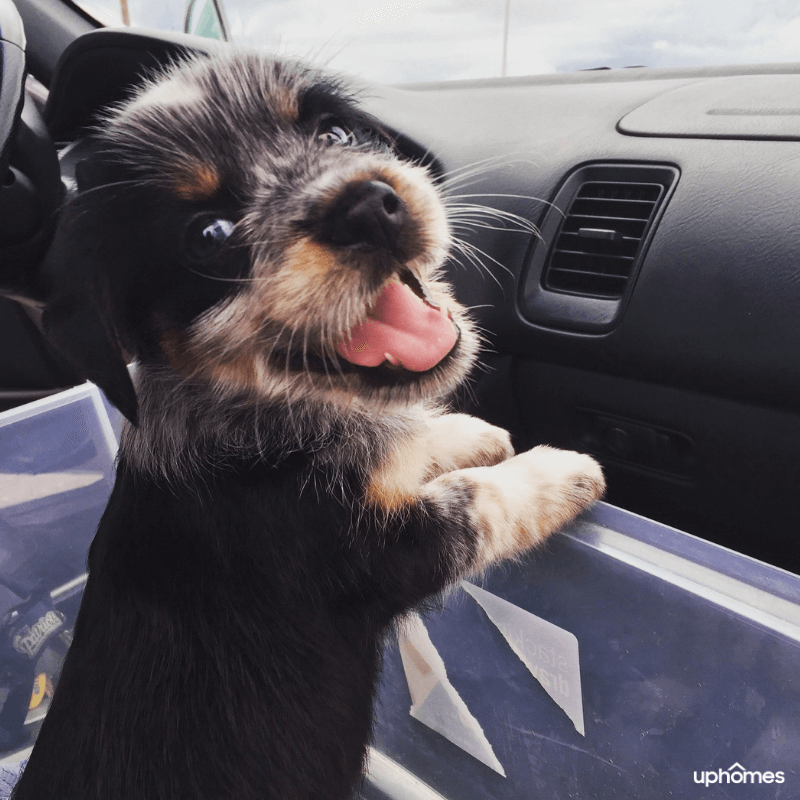March 16th, 2021


How to Calm an Anxious Pet When Moving to a NewPlace
Moving to a newhome can be really exciting, but have you ever tried moving with your pet? If you are a pet parent you might come to realize that moving to a new neighborhood can be a traumatizing experience for your furry friend. While some pets may seem to adjust relatively easily to a new environment, others can be prone to anxiety. This stress and fear is caused by an abrupt change in surroundings and can be seen affecting older pets or pets with a routine most often.
While this sudden uprooting can be scary for your pet, it is important to remember that they just need time to adjust. If only we could speak to them and explain what is going on, it would make the process a whole lot easier. But instead, there are steps to take as pet owners to help them acclimate to their new environment. Read on in this guide for some helpful tips to calm your anxious pet when moving to a new home.

Signs of Anxiety in Your Pet
It is important to look out for signs of stress in your pet when moving. Once you realize that your pet is showing signs of stressful behavior, the quicker you will be able to treat it. Keep in mind that some symptoms of anxiety may not be as noticeable as others. With that being said, any signs from your pet that are out of the norm should be looked out for.
Here are some signs of pet anxiety to consider:
-
Panting
-
General restlessness
-
Barking
-
Whining
-
Ears back
-
Tail tucked
-
Trembling or shaking
-
Drooling
-
Not eating or showing a lack of interest in food
-
Urinating inside or anywhere they should not
-
Destructive behavior
-
Hiding
-
Low activity levels
-
Biting
-
Escape behavior
Look out for any of these behaviors and note if they are unusual coming from your pet. Also, make sure to document whether any of these behaviors are a one-time occurrence or a repeat offense. If any of these behaviors are happening more than once and on a frequent basis once you have moved, it is most likely due to anxiety.

How to Treat Pet Anxiety
Visit yourNew HomeBeforeMoving
If you are touring your new home, perhaps you can bring your pet along. While this may not always be a feasible option, if you are moving somewhere close to your current location this might be a good idea. Check beforehand with yourRealtor about bringing your pet along, but if you can it would allow them to get used to the area. Even if your pet just gets to play outside in the yard, it would help the newhome seem less foreign once move-in day comes along. The scent of the new surroundings will be much more familiar!
Treats and toys
Make sure to pack and bring along all of your pet’s favorite treats and toys when moving to your new home. Pets, especially dogs, like to lick things in order to soothe themselves and relax. If you give your pet something to chew and lick, it will help keep them occupied. These toys and treats will be a much-needed distraction and will allow your pet to adjust to their new space. Plus, if you bring along your pet’s favorite chew toys it will comfort them having something that they are used to. As a caution, do not overdo it with the treats, but it is always a great idea to reward good behavior in this new location.

Create a safe place for your pet
Before unpacking and rearranging furniture, one of the first things that the pet parent should do is set up a safe place for your pet. Find a corner or space in a room to set up all of your pet’s things. This may include laying down a blanket, putting out a dog bed, setting up a litter box, treats, toys, and a food and water bowl. Being able to see and smell all of their familiar items in the new environment will hopefully start to ease their anxiety. Encourage your pet to roam and explore the new space. Having their own designated spot that your pet can relax in will start to get them used to the new area.
Keep a routine
If your pet is used to waking up at seven in the morning, eating breakfast at eight, and going on a walk at nine, then keep the same schedule. While it might not sound that important as a human, too much change can be a bad thing for your pet. Oftentimes, your pet relies on a sense of routine to make sense of their day. This routine is how they will learn to adjust to their new space. If their schedule is suddenly dropped or rearranged, it will only add more stress to the situation. While it is understandable to have to change some parts of your routine when moving, try to stick to some familiarities for the sake of your pet’s sanity. The more routine your day is, the smoother the transition will be.
Give lots of attention
Your pet loves when you give them attention. They absolutely adore you and all they ever want is some one-on-one time with you. While moving can be hectic and crazy, part of keeping your pet as stress-free as possible is by showering them in love and support. Take a break here and there while decorating your new space to play fetch or to cuddle on the couch. Give them all of the belly rubs that their little heart desires. Your pet loves you so much that they often pick up on your own behavior. It is a known scientific fact that dogs, in particular, imitate their owners while often taking on the same personality traits. If you seem comfortable in your newhome while spending time with your pet, they will pick up on that energy and in turn learn to love their new environment with you.

Playtime and exercise
If your pet has a bunch of pent-up energy then it will do more harm than good. Your pet is meant to run around and play. Much like humans, if your pet is sitting around with nothing to do they will get bored and anxious. If they have too much energy built up it will only add to their stress. So to avoid this, take them out and let them get exercise. Take them on a long walk to explore your new area, play fetch with them outside, or teach them some new tricks. You can even get them a new toy to entertain themselves with.
Stay home as much as you can at first
If you move in and then automatically leave your pet alone in your new environment, it will scare your pet more, to say the least. If you bring them to the new space and leave them without getting them comfortable first, they might think you are not coming back. Understandably, it might be hard to take extra time off of work when moving, but ideally, your pet should not be left alone for the first few days. The more you are around them, the more that your pet can get comfortable. While this might mean staying inside for a while or taking your pet everywhere with you, it will be worth it in the end. If an emergency arises and you have to leave, it might be a good idea to let a close family member or friend familiar with your pet take care of them in your home. Once they start to get acclimated and comfortable, it will be easier for them to be left alone.
Supplements and stress relief products
Pet anxiety is common and happens often. So much so that there are now supplements and natural remedies that your pet can turn to if their anxiety becomes too much. While this might not be the answer for all pets, there are now CBD Hemp Oil Supplements that can be given to your pet. This pet-friendly CBD oil is all-natural and is proven to be a safe and effective treatment for pet stress and anxiety. This CBD oil is from the cannabis plant and contains no THC. This CBD oil has no flavor and can be easily added to treats and food. If your pet is prone to anxiety, or if you think that they will become easily anxious during your move, then perhaps give your pet CBD oil beforehand as a preventative measure. There are a bunch of CBD oil brands for your pet on the market to choose from. Do some research and find out if this is the best option for you and your pet.
It will take time for your pet to adjust.
Overall, moving is stressful for everyone. The best thing that you can do is be patient and loving while your pet adjusts to their new space. It is important to recognize that this move is harder on them than it is on you. If you notice that your pet is acting out or showing any signs of the behavior listed above, then your pet is dealing with anxiety. By following the steps in this guide, you will be able to help your pet transition easily and reduce this stress. In the end, your pet will just need time to adjust. Sometimes it can take up to about three weeks for your pet to get used to its new home. If you are understanding and spend time with them, your furry companion will be happy again in no time.


Ryan Fitzgerald
Hi there! My name is Ryan Fitzgerald, and I am a REALTOR®. My goal is to help you learn more about real estate through our Real Estate Blog! Hopefully, you enjoyed the above blog post and it found a way to provide help or value to you. When you're ready to buy or sell a home of your own let us know here. Please feel free to join the conversation by dropping us a comment below.

